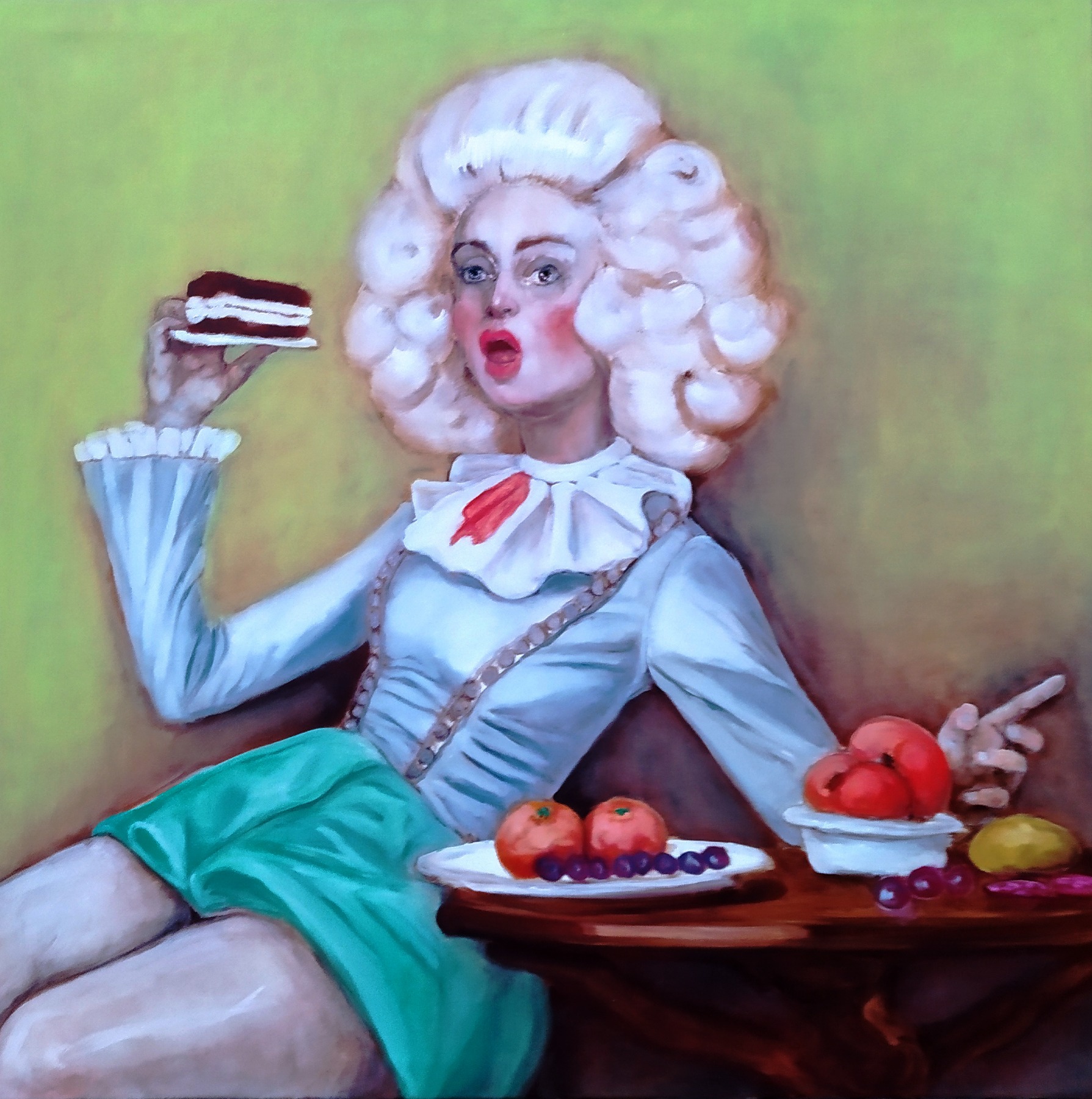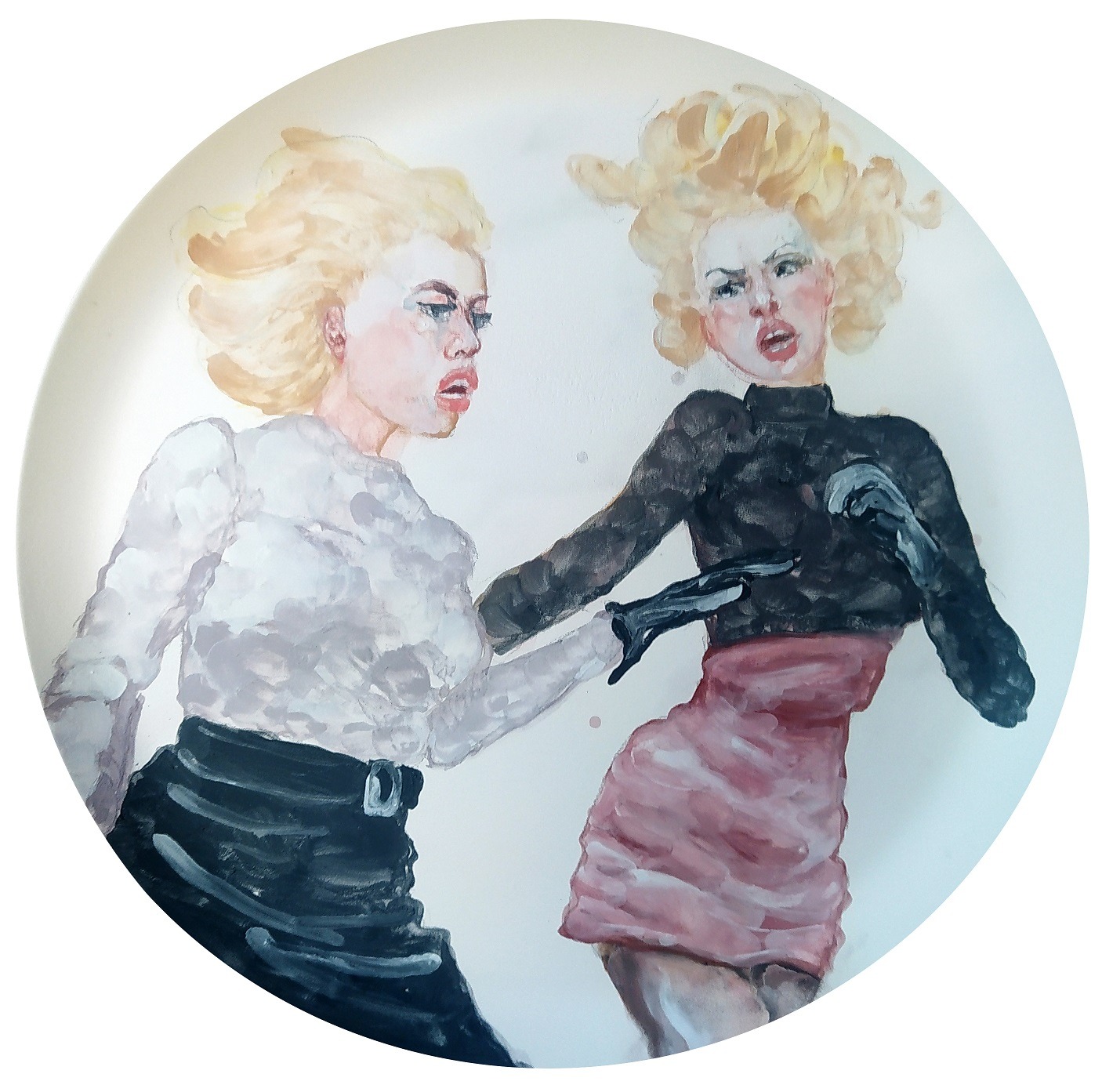
We are born to rule our own kingdoms
Ramiro Camelo
An interview with Tallinn-based artist Katrin Valgemäe
“Queens of Chaos”, a solo exhibition by Tallinn-based artist Katrin Valgemäe, opens at Myymälä 2 in Helsinki on December 17. Valgemäe is an unconventional painter who defies convention. Her art devises an idyllic parodic universe built through a playful conscious eccentricity, which is the basis of her laid-back pictorial style. Valgemäe talks with the exhibition’s curator, Ramiro Camelo, about her troubled memories during the Soviet occupation, the agitated lifestyle in 90s Tallinn, and the inspiration behind her Myymälä 2 exhibition.
Hello, Katrin. It’s a bit of a cliché, but – let’s start from the beginning. Can you remember the moment or day when you thought about and/or decided to become an artist? What situations or contexts do you think influenced that decision?
When I was very young, I used to create one-line portraits of my relatives while they sat around a long table. Everyone said I should become an artist. So, I asked my father to send me to art school, which I then completed at age 16. However, I then stopped making art. When I turned 28, I once again found myself at a dead end in my life. I was in a complete crisis and felt lost. It was at this point that I decided to make another turn in my life. I realized that I likely had at least 50 more years to live, and I began to reflect on what had brought me joy. I remembered my time at art school, how I used to travel by bus to the other end of the city in all kinds of weather, and even when tired, the moment I started painting, all weariness disappeared and time seemed to fly by unnoticed. This was my place. So I enrolled in the EKA preparatory courses for a year, and subsequently, embarked on a bachelor of arts program at EKA. Since then, I have never looked back!
Katrin Valgemäe. "Buffet of Joy", 90x90cm, oil on canvas, 2023
We will return to your time at EKA later on. In the meantime, I would like you to expand more on the past. What are your memories of the 90s? It’s a period that I can imagine was very significant and rapturous – the first years after the restoration of independence. I understand that as a teenager you lived in Lasnamäe. In your opinion, what situations and social changes of the the 90s do you think shaped your adolescent years the most?
As a teenager, I remember there were no rules...or at least it felt that way to me. I felt completely free. My parents were struggling financially and with each other, leaving them with no time nor attention for me. The school system also seemed quite lax. I watched Finnish TV, which felt like a window to a paradise where people were beautiful and the packages were even more beautiful. The things I saw there were so different from the world I was living in that it made a great impression on me. Advertisements on Finnish TV became like a part of my identity, which is something I currently love to play with. And, of course, with an absence of rules, there were wild parties and raves. So, I spent most of the 90s partying.
I also remember that it was the era of privatization. During Soviet times, there was no private property or business. I recall that in 1992, my mother and father started a small baking business. However, it didn’t last. In a capitalist society, one has to be sharp and have good knowledge to survive rather than simply be in a certain place and do specific things, which had been the norm for most. As a result, many people faced challenges while others became extremely wealthy, especially those who privatized assets.
Katrin Valgemäe. "Milk" 100x80cm, oil on canvas, 2023
Continuing on that subject, if you had the possibility to travel back in time and edit history, what would you change in 1990s Tallinn?
I don’t know if I would like to edit the history of 90s Tallinn. Apart from the potholed streets with mud puddles – it was challenging to move around without getting one’s feet dirty. However, I think I would make my life easier with the knowledge I have now. At the same time, I’m grateful that I grew up with such freedom and wildness in my youth. Without that period, I might not have developed the strength and endurance I possess today, and my current art might not have been the same.
Let’s go back to your time at EKA. What was your experience as a student like? For example, what did you like or dislike about being at art school?
EKA was my rebirth, I believe. I became a new person through the years I spent there, and I cherished the school immensely. I’m really glad that I attended the ceramic department in addition to practicing underglaze painting, which gave a new dimension to my art practice.
However, what I did dislike was that during my master’s program, the structure remained identical to that of the bachelor’s program – with tasks assigned by the lecturers. I simply wanted to concentrate on my art and receive their feedback. Anyway, I became pregnant and dropped out of school at that point. I believe they’ve made significant changes there since then.
Katrin Valgemäe. "Pedigree" 90x90cm, oil on canvas, 2023
Could you elaborate on how you came up with the idea for the exhibition “Queens of Chaos”, which you are now presenting at Myymälä 2 in Helsinki?
I feel that chaos is a big part of my life; I find irrational behaviour oddly appealing. “Queens of Chaos” is a journey where one thing leads to another, and everything starts to happen. It’s a process in which I move according to my intuition. I play, and the important thing is to have fun while simultaneously focusing on continuous development. I have a principle that each subsequent painting should surpass the previous one, although, truth be told, that does not always happen.
You mentioned spending most of the 90s partying – I’m guessing that it wasn’t only you, but that most artists in Tallinn’s art scene were living with this happy-go-lucky attitude of debauchery and mischief. Accordingly, do you think that this “attraction to irrational behavior” was a form of escapism and indifference to the hard realities of day-to-day life in those rather gloomy 90s?
Yes, it was escapism. I realized that life was often far from the idealized version I had in mind. It seemed that no one could truly provide the answers for how to find the happiness I sought. There was the harsh reality that life would most likely be tough, and that one had to adapt. But I refused to accept that. My rebellion was irrational behaviour – skipping school, partying, getting drunk, and leaving home at a young age.
Katrin Valgemäe. Porcelain plate from the series "Queens of Chaos", underglaze painting on porcelain plate, D:25cm
Looking at your paintings, it is evident that they imply an ironic, playful and naughty viewpoint of consumerism. While preparing this exhibition, I discovered that you have dreadful memories of Soviet propaganda. However, I would say that you very intentionally are producing more than a commentary about the legacy of that Soviet-era ideological doctrine. To what extent are you trying to exorcize or purge yourself of depressing recollections of that propaganda?
I deal with a sense of “lacking”; it’s my legacy from the Soviet era. I’ve come to realize that this feeling of desiring something, and not being able to have it, leads to cravings, disappointments, and frustrations. Consumerism is one of the forms of expression of “lacking”. Yet we cannot diminish this sense of lacking by consuming products because its roots run much deeper – as in, I want to live, I want to be happy, I want to love and be loved, I want to feel safe being myself. In my art, I explore this concept with a playful irony, which serves as a form of therapy for me.
Katrin Valgemäe. Porcelain plate from the series "Queens of Chaos", underglaze painting on porcelain plate, D:25cm
In “Ways of Seeing”, John Berger theorizes about how art establishes the presence of women. He says that her gestures, her clothes, what she says, what she likes...everything contributes to becoming a presence. Berger stresses that a woman’s presence is more than physical – it’s like a vibe, a kind of heat, smell or aura. He goes on: A woman must continually watch herself. She is almost continually accompanied by her own image of herself. Whilst she is walking across a room or whilst she is weeping at the death of her father...From earliest childhood she has been taught and persuaded to survey herself continually. And so she comes to consider the surveyor and the surveyed within her as the two constituent yet always distinct elements of her identity as a woman. Her own sense of being in herself is supplanted by a sense of being appreciated as herself by another. After that very long preamble, I would like to ask – what is your interest, your purpose or rationale, for representing the women in your paintings in an unruly, defiant and rebellious mood?
I portray women as unrestrained and defiant figures in order to emphasize the importance of breaking free from old patterns and recognizing inner strength and individuality. In my paintings, those women are wearing their attitude like a crown, turning “I have nothing to wear” into “I have everything to dare!” My art serves as a celebration of endless possibilities for self-expression and empowerment, reminding us all that we are born to rule our own kingdoms.
Katrin Valgemäe. Porcelain plate from the series "Queens of Chaos", underglaze painting on porcelain plate, D:25cm
If we agree that your exhibition is about revisiting the past with the spirit of the present, let’s imagine you could go back in time to meet yourself knowing what you know now. What would you tell or advise to that Katrin who is living life in her early 20s?
Don’t forget that life is like a shirt turned inside out – it just needs to be taken off and turned around.
Let’s finish with a bit of fantasizing… It might be sometimes naughty or outlandish in terms of building a national narrative to think of a nation as the protagonist of a fairy tale. Because I know you have a vivid imagination, could you try to describe Estonia or the Estonian way of being as a fairy tale?
I can imagine Estonia as a small but determined protagonist, navigating its way through historical challenges and changes. In this fairy tale, Estonia could be portrayed as a character with a deep connection to nature, and whose journey involves facing various political ideologies. Despite the trials and tribulations, Estonia could be depicted as a nation that holds onto its identity, language, and cultural heritage, much like the steadfast hero or heroine of a classic fairy tale.